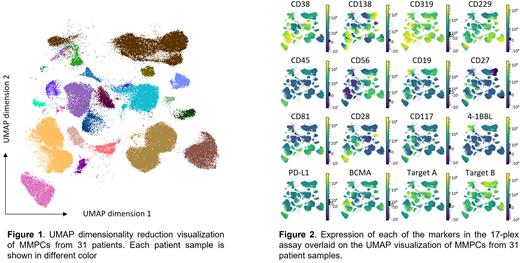Abstract
Background: Multiple Myeloma (MM) is a hematological malignancy also known as plasma cell myeloma or myeloma, a type of bone marrow cancer characterized by the proliferation of clonal malignant plasma cells (PCs). Characterization of multiple myeloma plasma cells (MMPCs) remains challenging due to their plasticity, especially in response to emerging targeted therapies such as anti-BCMA and anti-CD38. The need for novel options for comprehensive phenotyping remains high due to the evolving target expression profiles and dynamics across MM disease evolution and treatment lines. Recent progress in flow cytometry offers the opportunity to analyze more than 30 surface markers in one panel. This technology advance will help to address the current challenges, answer clinically relevant questions and generate data to enable translational research and identification of new drug targets or combination partners.
Methods: We present a novel 17-plex flow cytometry assay for immunophenotyping of PCs in RRMM patients enrolled in a global Phase I multi-center clinical study (NCT04557150). The panel relies on 5 markers for the identification of malignant plasma cells: CD38, CD138, CD45, CD319 and CD229. The inclusion of less commonly used markers (CD229, CD319) allows to overcome some of the challenges in MMPCs identification, such as CD138 instability and CD38 downregulation due to prior therapies. In addition, the assay includes markers commonly used to differentiate normal from malignant PCs (CD19, CD56, CD27, CD81, CD117, CD28). The panel also includes 2 immunotherapy target ligands (PD-L1 and 4-1BBL) and offers the possibility to measure another 3 clinically relevant targets on MMPCs, including BCMA. With this configuration, the assay allows relevant target antigen density quantification via the use of molecules of equivalent soluble fluorochrome (MESF) beads in 3 channels.
Results: We present examples of how to apply this strategy for a reliable identification of MMPCs in RRMM patient samples after up to 14 previous lines of therapies. The assay design permits a deep phenotypical characterization of MMPCs and pharmacodynamic changes in markers targeted by immunotherapy drugs, like anti-CD38 or anti-BCMA. As an example, we characterize BCMA and CD38 expression on the surface of MMPCs at the time of enrolment into a Phase I study. Finally, with the goal of discovering new biomarkers that could be overlooked in the traditional manual gating hierarchy applied in flow cytometry, we have visualized the results using dimensionality reduction analysis (Uniform Manifold Approximation and Projection, UMAP). Using this approach, we have observed high inter-patient heterogeneity of MMPC phenotypes. Furthermore, we could compare intra-patient differences in MMPC phenotype in two compartments, whole blood and bone marrow aspirate. Updated data will be presented.
Conclusion: The multi parameter flow cytometry assay described here represents a novel tool to reliably identify MMPCs in RRMM patients independently of commonly used unstable surface markers. Furthermore, it represents an important tool in the era of surface antigen targeted therapies (e.g., anti-BCMA) helping to understand drug resistance due to target loss.
Disclosures
Lelios:F. Hoffmann-La Roche AG: Current Employment, Current equity holder in publicly-traded company. Gómez:F. Hoffmann-La Roche AG: Current Employment, Current equity holder in publicly-traded company. Dekhtiarenko:F. Hoffmann-La Roche AG: Current Employment. Teixeira:F. Hoffmann-La Roche AG: Current Employment, Current equity holder in publicly-traded company. Bröske:Roche Diagnostics GmbH: Current Employment.
Author notes
Asterisk with author names denotes non-ASH members.


This feature is available to Subscribers Only
Sign In or Create an Account Close Modal